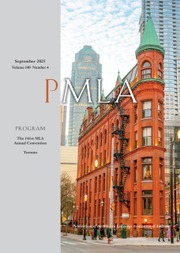Article contents
Extract
Interface, we think, is the screen, the display, the portal into the online world or computer. The GUI (Graphical User Inter-face), with its menu bars and navigational buttons, is so familiar that we tend to overlook the “gooeyness” of it—the mutable, mediating activity—and take interface for a thing, static, stable, and fixed. Or we take it as a representation of computational processes, a convenient translation of what is “really going on” inside. Neither could be further from actuality.
- Type
- The Changing Profession
- Information
- Copyright
- Copyright © 2013 by The Modern Language Association of America
References
Works Cited
Abrams, Meyer Howard. The Mirror and the Lamp: Romantic Theory and the Critical Tradition. New York: Oxford UP, 1953. Print.Google Scholar
Ackerman, Samuel K. Dimensions of Culture and Global Web User-Interface Design. Emeryville: Marcus, 2001. PDF file.Google Scholar
Bender, Gretchen, and Druckrey, Timothy, eds. Culture on the Brink. Seattle: Bay, 1994. Print.Google Scholar
Booth, Charlotte. Alan Kay and the Graphical User Interface. N.p.: n.p., n.d. PDF file.Google Scholar
Ciula, Arianna. “The New Edition of the Letters of Vincent Van Gogh on the Web.” Digital Humanities Quarterly 4.2 (2010): n. pag. Web. 16 Nov. 2012.Google Scholar
“Command-Line Interface.” Wikipedia: The Free Encyclopedia. Wikimedia Foundation, 11 Nov. 2012. Web. 16 Nov. 2012.Google Scholar
Engelbart, Douglas C. “Augmenting Human Intellect: A Conceptual Framework.” Augmenting Human Intellect: A Conceptual Framework. Doug Engelbart Inst., Oct. 1962. Web. 16 Nov. 2012.Google Scholar
The Father of Virtual Reality: Morton L. Heilig (1926-1997). N.p., n.d. Web. 16 Nov. 2012.Google Scholar
Garrett, Jesse James. “The Elements of the User Experience.”JJG.net. N.p., 2004. Web. 16 Nov. 2012.Google Scholar
Hiltzik, Michael. Dealers of Lightning: Xerox PARC and the Dawn of the Computer Age. New York: Harper, 1999. Print.Google Scholar
Hoffman, Donald D. The Interface Theory of Perception: Natural Selection Drives True Perception to Swift Extinction. N.p.: n.p., 2009. PDF file.Google Scholar
Jenkins, Henry, and Thorburn, David, eds. Democracy and New Media. Cambridge: MIT P, 2003. Print.CrossRefGoogle Scholar
Laurel, Brenda, ed. The Art of Human-Computer Interface Design. Reading: Addison, 1990. Print.Google Scholar
Lynch, Patrick J. “Visual Design for the User Interface Part 1: Design Fundamentals.” Journal of Biocommunications 21.1 (1994): 22–30. Yale Center for Advanced Instructional Media. Web. 27 Dec. 2012.Google Scholar
“Microsoft Bob.” Wikipedia: The Free Encyclopedia. Wikimedia Foundation, 16 Nov. 2012. Web. 16 Nov. 2012.Google Scholar
“Myron W. Krueger.” Wikipedia: The Free Encyclopedia. Wikimedia Foundation, 10 May 2012. Web. 16 Nov. 2012.Google Scholar
“Object-Oriented Programming.” Wikipedia: The Free Encyclopedia. Wikimedia Foundation, 12 Nov. 2012. Web. 16 Nov. 2012.Google Scholar
Parkes, M. B. “The Influence of the Concepts of Ordinatio and Compilatio on the Development of the Book.” Scribes, Scripts, and Readers. London: Hambledon, 1991. Print.Google Scholar
Penny, Simon. “Consumer Culture and the Technological Imperative: The Artist in Dataspace.” Digital Culture Readings. Dept. of Studio Art, U of California, Irvine, 2006. Web. 2 Nov. 2012.Google Scholar
Shneiderman, Ben. “Shneiderman's ‘Eight Golden Rules of Interface Design.‘” Josh Tenenberg's Homepage. N.p., n.d. Web. 2 Nov. 2012.Google Scholar
Soegaard, Mads. “Gestalt Principles of Form Perception.” Interaction Design Foundation. Interaction Design Foundation, n.d. Web. 13 Nov. 2012.Google Scholar
Sutherland, Ivan Edward. “Sketchpad: A Man-Machine Graphical Communication System.” Technical Report Number 574. U of Cambridge Computer Laboratory, Sept. 2003. Web. 16 Nov. 2012.Google Scholar
Thurlow, Crispin, Lengel, Laura, and Tomic, Alice, eds. Computer Mediated Communication: Social Interaction and the Internet. London: Sage, 2004. Print.Google Scholar
Vincent van Gogh: The Letters. Van Gogh Museum; Huygens Inst., June 2012. Web. 16 Nov. 2012.Google Scholar
Warde, Beatrice. “The Crystal Goblet; or, Printing Should Be Invisible.” The Crystal Goblet: Sixteen Essays on Typography. Selected and ed. Henry Jacob. Cleveland: World, 1956. 11–17. Print.Google Scholar
- 21
- Cited by


